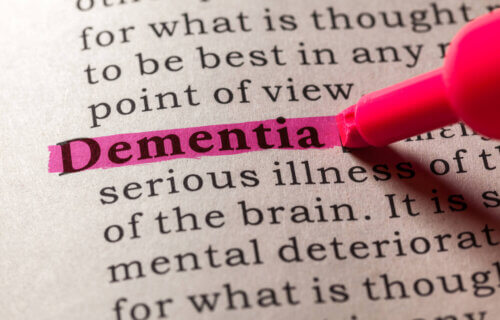Dementia is not a single disease. It is a general term that describes the impaired ability to think, remember, or make decisions that interferes with daily living. There are more than 200 subtypes of dementia. The four most common are Alzheimer’s disease, vascular dementia, dementia with Lewy bodies, and frontotemporal dementia.
There are about six million Americans currently living with dementia. Among people 55 and older, one out of six women and one out of 10 men will develop dementia in their lifetime.
Dementia is a heavily researched condition. For decades, though, scientists labored in vain to find a cause, a blood test, accurate imaging, or effective treatments. It is only in the last few years that remarkable progress has been made in all aspects of the condition – causes, risk factors, signs and symptoms, diagnosis, and treatment. There is now a new and exciting understanding of the effects of exercise, diet, the gut-brain connection, education, cognitive stimulation, and other factors on the development and management of dementia.
Despite all of that, there are still plenty of things about this condition that people get wrong. Let’s look at some of the common beliefs about dementia and examine which are fact and which are fiction:
1. Retention of old memories is characteristic of dementia
Fiction. Retention of old memories is characteristic of age-related memory changes but not dementia. Dementia is not a normal part of aging. Memory changes associated with normal aging include:
- Occasionally misplacing objects such as car keys
- Forgetting the name of an acquaintance
- Forgetting recent events
- Struggling to find a word while speaking but remembering it later
Language skills, knowledge built over years, and old memories are usually retained.
2. The greatest risk factor for dementia is aging
Fact. Increasing age is the biggest risk factor for developing dementia.
Dementia is more prevalent at older ages:
- About 3% of adults ages 70 to 74 had dementia in 2019, compared with 22% of adults ages 85 to 89 and 33% of adults ages 90 and older.
- Among adults ages 70 and older, 11% of women and 8% of men had dementia in 2019.
- An estimated 6.2 million Americans 65 and older are living with Alzheimer’s dementia in 2021. Seventy-two percent are 75 or older. One
in nine people 65 and older (11.3%) has Alzheimer’s dementia.
Almost two-thirds of Americans with Alzheimer’s disease are women. The proportion of adults 70 and older with dementia declined from 13 percent in
2011 to 10 percent in 2019. The share of older people with dementia decreases one percent to 2.5 percent per year, depending on the time frame and age group examined. If current demographic and health trends continue, more than nine million Americans could have dementia by 2030 and nearly 12 million by 2040.

3. Using unusual words for familiar objects is characteristic of dementia
Fact. Using unusual words for familiar objects may begin early in dementia, but an occasional occurrence of this sign may seem inconsequential. As dementia progresses, this sign will increase in frequency until it triggers concern.
Since dementia is a nonspecific description, there is a great diversity of signs and symptoms among individuals, somewhat dependent on the specific disease. These will be affected to various degrees:
- Memory
- Attention
- Reasoning and judgment
- Communication skills
- Visual perception other than normal age-related changes in vision
- Forgetting old memories
- Forgetting the names of family or friends
- Getting lost in a familiar neighborhood
- Inability to complete tasks independently
4. The Hispanic population has the greatest incidence of dementia
Fiction. Hispanic Americans are 1.5 times more likely to develop dementia than White Americans. However, Black Americans are twice as likely as White Americans to develop dementia. Other risk factors for dementia include:
- Positive family history – Individuals with parents or siblings with dementia are 10 to 30 percent more likely to develop dementia.
- Cardiovascular disease – High blood pressure, high cholesterol, and smoking increase the risk for dementia, especially without proper treatment.
- Traumatic brain injury is associated with a greater risk for dementia.
5. The states with the greatest prevalence of people with Alzheimer’s disease are New York, Maryland, Florida, and Mississippi
Fact. States with the greatest number of people age 85 and older will have the greatest numbers of people with Alzheimer’s disease. Of their populations’ percentages with Alzheimer’s disease, Maryland has 12.9 percent, New York has 12.7 percent, Florida, and Mississippi
both have 12.7 percent.
6. There is no readily available blood test for Alzheimer’s disease
Fiction. A keyword here is “readily.” The use of blood samples to detect amyloid and other markers of Alzheimer’s disease has become standard procedure for monitoring patients in clinical trials. Those tests, however, required lengthy and complex processing and strict temperature control. They were not practical for use in the general population.
More recently scientists have developed a test in which a drop of blood from a finger prick is applied to a blood spot card, where it dries and remains at room temperature. Handling and processing are simplified. The results were accurate. This method may be useful not just for diagnosis but also to monitor the effectiveness of treatment and disease progression. More clinical trials with larger numbers of participants are necessary before they can be considered for use in the general population.
The findings were presented at the Alzheimer’s Association International Conference (AAIC) 2023.
7. The signature symptom of Alzheimer’s disease is trouble remembering recent events
Fact. Trouble remembering recent events, such as a conversation that took place from a few minutes to a few hours previously is an identifying feature of Alzheimer’s disease. This symptom occurs early in the disease. It is later in the disease when there is a loss of older memories. Alzheimer’s disease accounts for 60 to 80 percent of all cases of dementia.

(© Orawan – stock.adobe.com)
8. Vascular dementia is linked to strokes or other issues with blood flow to the brain
Fact. Conditions that affect blood flow, such as diabetes, high blood pressure, and high cholesterol are risk factors for vascular dementia. Symptoms vary with the area of the brain affected. The disease progresses in steps. Symptoms will suddenly get worse as the individual suffers more strokes or mini-strokes.
9. Frontotemporal dementia is characterized by difficulties with understanding spoken language or verbalizing thoughts
Fact. Aphasia, which is difficulty with understanding or generating speech, can be characteristic of frontotemporal dementia. Changes in personality and behavior are characteristic of this type of dementia. People with this condition may behave inappropriately and embarrass themselves by making offensive comments. They often neglect responsibilities at home or work.
10. FDA-approved drugs for Alzheimer’s dementia can only lessen symptoms or slow the progression of the disease
Fact. No treatments have been able to reverse the cognitive decline of Alzheimer’s disease. The Food and Drug Administration (FDA) recently granted full approval to a new drug called lecanemab, which has been shown to moderately slow cognitive and functional decline in early-stage cases of the disease.
In January, the FDA gave the medication accelerated approval based on amyloid plaque clearance. Christopher van Dyck, MD, director of Yale’s Alzheimer’s Disease Research Unit, and lead scientist of a study published in the Jan. 5 issue of The New England Journal of Medicine that shared results of a Phase III clinical trial of lecanemab.
Sold under the brand name Leqembi™ and made by Eisai in partnership with Biogen Inc., the drug is delivered by an intravenous infusion every two weeks. Lecanemab removes a sticky protein from the brain that is believed to cause Alzheimer’s disease to progress.
“The antibody treatment selectively targets the forms of amyloid protein that are thought to be the most toxic to brain cells,” says Dr. van Dyck.
Study participants who received the treatment had a significant reduction in amyloid burden in imaging tests, usually reaching normal levels by the end of the trial. Participants also showed a 26 percent slowing of decline in a key type of cognitive function and a 37 percent slowing of decline in a measure of daily living compared to the placebo group.
Lecanemab is already being tested in the global AHEAD study for individuals who are still cognitively normal but at high risk of symptoms due to elevated levels of brain amyloid.
The cost of the drug is about $26,000.00 per month. After the FDA granted full approval of the drug, Medicare stated that they will cover 80 percent of the cost. That leaves $5,200.00 per month to be covered by other resources.
Author’s note: Dr. van Dyck disclosed that he is a paid consultant for the pharmaceutical company Eisai, which funded the trials and manufactures the drug – a potential conflict of interest. Additional source: About Dementia | Aging (cdc.gov)

